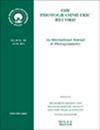成像雷达在土地利用中的应用:回顾与展望
IF 3.6
3区 地球科学
Q2 GEOGRAPHY, PHYSICAL
引用次数: 1
摘要
在1981年6月和7月期间,作为欧洲SAR 580运动的一部分,在10个欧洲国家的选定地点获得了合成孔径雷达图像。当处理后的数据可供调查人员使用时,英国将通过18个批准的实验(欧洲有56个)对这些图像进行评估。为了协助评价过程,对成像雷达在农业和城市地区应用的一些最新研究进行了综述。研究了地形参数和雷达参数对作物分类精度的影响。考虑了定量和定性方法在雷达数据分类中的相对优点。雷达与陆地卫星数据结合使用,分类精度显著提高。空间滤波技术的发展可能有助于解决城市地区由于图像色调依赖于地面特征和雷达观察方向的相对对准而产生的问题。1981年,在一份文件中,欧洲运动委员会(SAR) 580,招募了雷达成像仪的研究人员,合成了雷达成像仪的研究人员,选择了欧洲的研究人员和研究人员。这些受训者将在皇家大学(Royaume-Uni)的18个项目中接受评估,而不是被接受的项目(在欧洲共有56个项目);我们的工作开始于我们的工作人员,我们的工作人员,我们的工作人员,我们的工作人员。在此基础上,分析了影像雷达在区域、农业和城市等领域的最新研究成果和应用。L'une de - ces研究提供了完整的地形参数效应和文化分类的准确性。这些优点的相互作用的方法,定量和定性的方法,分类,雷达和平均检查。他恢复了雷达和陆地卫星的单一组合,这使得分类的精度大大提高。在空间探测过程中,需要使用空间探测技术,需要使用空间探测技术,需要使用空间探测技术,需要使用空间成像技术,需要使用空间成像技术,需要使用空间成像技术,需要使用空间成像技术,需要使用空间成像技术,需要使用空间成像技术,需要使用空间成像技术。1981年6月1日至7月1日,在10个欧洲国家的陆地上,在10个欧洲国家的陆地上,在10个欧洲国家的陆地上,在10个欧洲国家的陆地上,在10个欧洲国家的陆地上,在5个欧洲国家的陆地上。模具分析:在欧罗巴(欧罗巴)的第18期(欧罗巴第56期)的第18期(欧罗巴第56期)。2 .在分析过程中,研究人员对自然环境下的自然环境和自然环境下的自然环境进行分析。他说:“我是说,我们是说,我们是说,我们是说,我们是说,我们是说,我们是说,我们是说,我们是说,我们是说,我们是说,我们是说,我们是说,我们是说,我们是说,我们是说,我们是说。”相对性质:定量和定性的性质。Landsat-Daten的组合。在德国,我们的研究对象是德国的科学工作者,我们的研究对象是德国的科学工作者,我们的研究对象是德国的科学工作者,我们的研究对象是德国的科学工作者。本文章由计算机程序翻译,如有差异,请以英文原文为准。
LAND USE APPLICATIONS OF IMAGING RADAR: RETROSPECT AND PROSPECT
During June and July 1981, synthetic aperture radar imagery was acquired of selected sites in ten European countries as part of the European SAR 580 campaign. Evaluation of this imagery in the UK will be carried out by 18 approved experiments (out of 56 for Europe) when the processed data becomes available to investigators. To assist the evaluation process, a review is given of some recent research on applications of imaging radar in agricultural and urban areas. Research is described which considered the effects of terrain parameters and radar parameters on crop classification accuracy. The relative merits of a quantitative or a qualitative approach in classification of radar data are considered. Combined use of radar and Landsat data achieves a marked improvement in classification accuracy. The development of spatial filtering techniques may assist in the problem in urban areas resulting from the dependence of image tone on the relative alignment of ground features and radar look direction.
Resume
Pendant les mois dejuin et juillet 1981, on a, dans le cadre de la campagne europeenne SAR 580, recueilli des donnees de radar imageur a synthese d'ouverture sur des sites choisis dans une dizaine de pays d'Europe. Ces donnees seront evaluees au Royaume-Uni au moyen de 18 experiences ayant ete acceptees (sur un total de 56 menees en Europe); ce travail commencera des que les donnees une fois traitees seront distribuees aux chercheurs. Pour accompagner cette procedure d'evaluation, on fournit une analyse de quelques recherches recentes sur les applications de l'imagerie radar aux zones agricoles et urbaines.
L'une de ces recherches prenait en compte les effets des parametres lies au terrain sur l'exactitude de la classification des cultures. Les merites reciproques des approches quantitatives et qualitatives dans la classification des donnees radar sont egalement examines.
Le recours a une combinaison de donnees radar et Landsat permet d'ameliorer de maniere significative l'exactitude de la classification. La mise en oeuvre des techniques de filtrage spatial peut aider a reduire, dans les zones urbaines, les consequences nefastes sur la tonalite de l'image, d'objets au sol en alignement relatif avec la direction d'observation du radar.
Zusammenfassung
Im Juni und Juli 1981 erfolgten Radaraufnahmen mittels synthetischer Apertur von ausgewahlten Gebieten in 10 europaischen Landern als Teil der Europaischen SAR 580 Kampagne. Die Analyse dieser Aufzeichnungen wird im Vereinigten Konigreich durch 18 (aus insgesamt 56 fur Europa) bestatigte Experimente erfolgen, nachdem die Daten zur Verfugung stehen. Um den Analysenprozess zu unterstutzen, wird ein Uberblick uber kurzliche Forschungen zu Radaraufzeichnungen in landwirtschaftlichen und stadtischen Gebieten gegeben. Es werden auch Forschungen beschrieben, bei denen die Einflusse von Gelandeparametern auf die Genauigkeit der Ernteklassifizierung untersucht wurden. Der relative Wert eines quantitativen oder qualitativen Versuchs zur Klassifizierung von Radardaten wird abgeschatzt. Eine Kombination von Radarund Landsat-Daten ergibt eine merkliche Verbesserung bei Klassifizierungsgenauigkeit. Die Entwicklung von Verfahren der raumlichen Filterung kann von Wert bei stadtischen Gebieten sein, weil es eine Abhangigkeit des Grauwertes von der relativen Ausdehnung von Gelandecharakteristika und der Richtung der Radaraufnahme gibt.
求助全文
通过发布文献求助,成功后即可免费获取论文全文。
去求助
来源期刊

Photogrammetric Record
地学-成像科学与照相技术
CiteScore
3.60
自引率
25.00%
发文量
71
审稿时长
>12 weeks
期刊介绍:
The Photogrammetric Record is an international journal containing original, independently and rapidly refereed articles that reflect modern advancements in photogrammetry, 3D imaging, computer vision, and other related non-contact fields. All aspects of the measurement workflow are relevant, from sensor characterisation and modelling, data acquisition, processing algorithms and product generation, to novel applications. The journal provides a record of new research which will contribute both to the advancement of photogrammetric knowledge and to the application of techniques in novel ways. It also seeks to stimulate debate though correspondence, and carries reviews of recent literature from the wider geomatics discipline.
Relevant topics include, but are not restricted to:
- Photogrammetric sensor calibration and characterisation
- Laser scanning (lidar)
- Image and 3D sensor technology (e.g. range cameras, natural user interface systems)
- Photogrammetric aspects of image processing (e.g. radiometric methods, feature extraction, image matching and scene classification)
- Mobile mapping and unmanned vehicular systems (UVS; UAVs)
- Registration and orientation
- Data fusion and integration of 3D and 2D datasets
- Point cloud processing
- 3D modelling and reconstruction
- Algorithms and novel software
- Visualisation and virtual reality
- Terrain/object modelling and photogrammetric product generation
- Geometric sensor models
- Databases and structures for imaging and 3D modelling
- Standards and best practice for data acquisition and storage
- Change detection and monitoring, and sequence analysis
 求助内容:
求助内容: 应助结果提醒方式:
应助结果提醒方式:


